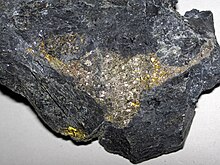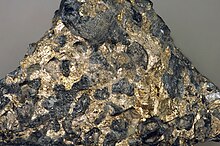User:Praseodymium-141/Palladium compounds
Palladium compounds are compounds formed by the element palladium (Pd). These compounds exist primarily in the 0 and +2 oxidation state. Other less common states are also recognized. Generally the compounds of palladium are more similar to those of platinum than those of any other element.
-
Structure of α-PdCl2
-
Structure of β-PdCl2
Palladium(II)[edit]
Palladium(II) chloride is the principal starting material for other palladium compounds. It arises by the reaction of palladium with chlorine. It is used to prepare heterogeneous palladium catalysts such as palladium on barium sulfate, palladium on carbon, and palladium chloride on carbon.[1] Solutions of PdCl2 in nitric acid react with acetic acid to give palladium(II) acetate, also a versatile reagent. PdCl2 reacts with ligands (L) to give square planar complexes of the type PdCl2L2. One example of such complexes is the benzonitrile derivative PdX2(PhCN)2.[2][3]
The complex bis(triphenylphosphine)palladium(II) dichloride is a useful catalyst.[4]



Palladium(0)[edit]
Palladium forms a range of zerovalent complexes with the formula PdL4, PdL3 and PdL2. For example, reduction of a mixture of PdCl2(PPh3)2 and PPh3 gives tetrakis(triphenylphosphine)palladium(0):[5]
- 2 PdCl2(PPh3)2 + 4 PPh3 + 5 N2H4 → 2 Pd(PPh3)4 + N2 + 4 N2H5+Cl−
Another major palladium(0) complex, tris(dibenzylideneacetone)dipalladium(0) (Pd2(dba)3), is prepared by reducing sodium tetrachloropalladate in the presence of dibenzylideneacetone.[6]
Palladium(0), as well as palladium(II), are catalysts in coupling reactions, as has been recognized by the 2010 Nobel Prize in Chemistry to Richard F. Heck, Ei-ichi Negishi, and Akira Suzuki. Such reactions are widely practiced for the synthesis of fine chemicals. Prominent coupling reactions include the Heck, Suzuki, Sonogashira coupling, Stille reactions, and the Kumada coupling. Palladium(II) acetate, tetrakis(triphenylphosphine)palladium(0) (Pd(PPh3)4, and tris(dibenzylideneacetone)dipalladium(0) (Pd2(dba)3) serve either as catalysts or precatalysts.[7]
Other oxidation states[edit]
Although Pd(IV) compounds are comparatively rare, one example is sodium hexachloropalladate(IV), Na2[PdCl6]. A few compounds of palladium(III) are also known.[8] Palladium(VI) was claimed in 2002,[9][10] but subsequently disproven.[11][12]
Mixed valence palladium complexes exist, e.g. Pd4(CO)4(OAc)4Pd(acac)2 forms an infinite Pd chain structure, with alternatively interconnected Pd4(CO)4(OAc)4 and Pd(acac)2 units.[13]
When alloyed with a more electropositive element, palladium can acquire a negative charge. Such compounds are known as palladides, such as gallium palladide.[14] Palladides with the stoichiometry RPd3 exist where R is scandium, yttrium, or any of the lanthanides.[15]
See also[edit]
References[edit]
- ^ Mozingo, Ralph (1955). "Palladium Catalysts". Organic Syntheses; Collected Volumes, vol. 3, p. 685.
- ^ Anderson, Gordon K.; Lin, Minren; Sen, Ayusman; Gretz, Efi (1990). Bis(Benzonitrile)Dichloro Complexes of Palladium and Platinum. Inorganic Syntheses. Vol. 28. pp. 60–63. doi:10.1002/9780470132593.ch13. ISBN 978-0-470-13259-3.
- ^ Zalevskaya, O. A; Vorob'eva, E. G; Dvornikova, I. A; Kuchin, A. V (2008). "Palladium complexes based on optically active terpene derivatives of ethylenediamine". Russian Journal of Coordination Chemistry. 34 (11): 855–857. doi:10.1134/S1070328408110110. S2CID 95529734.
- ^ Miyaura, Norio & Suzuki, Akira (1993). "Palladium-catalyzed reaction of 1-alkenylboronates with vinylic halides: (1Z,3E)-1-Phenyl-1,3-octadiene". Organic Syntheses; Collected Volumes, vol. 8, p. 532.
- ^ Coulson, D. R.; Satek, L. C.; Grim, S. O. (1972). 23. Tetrakis(triphenylphosphine)palladium(0). Inorganic Syntheses. Vol. 13. pp. 121–124. doi:10.1002/9780470132449.ch23. ISBN 978-0-470-13244-9.
{{cite book}}:|journal=ignored (help) - ^ Takahashi, Y; Ito, Ts; Sakai, S; Ishii, Y (1970). "A novel palladium(0) complex; bis(dibenzylideneacetone)palladium(0)". Journal of the Chemical Society D: Chemical Communications (17): 1065. doi:10.1039/C29700001065.
- ^ Crabtree, Robert H. (2009). "Application to Organic Synthesis". The Organometallic Chemistry of the Transition Metals. John Wiley and Sons. p. 392. ISBN 978-0-470-25762-3.
- ^ Powers, David C; Ritter, Tobias (2011). "Palladium(III) in Synthesis and Catalysis". Higher Oxidation State Organopalladium and Platinum Chemistry. Topics in Organometallic Chemistry. Vol. 35. pp. 129–156. doi:10.1007/978-3-642-17429-2_6. ISBN 978-3-642-17428-5. PMC 3066514. PMID 21461129.
- ^ Chen, W; Shimada, S; Tanaka, M (2002). "Synthesis and Structure of Formally Hexavalent Palladium Complexes". Science. 295 (5553): 308–310. Bibcode:2002Sci...295..308C. doi:10.1126/science.1067027. PMID 11786638. S2CID 45249108.
- ^ Crabtree, R. H (2002). "CHEMISTRY: A New Oxidation State for Pd?". Science. 295 (5553): 288–289. doi:10.1126/science.1067921. PMID 11786632. S2CID 94579227.
- ^ Aullón, G; Lledós, A; Alvarez, S (2002). "Hexakis(silyl)palladium(VI) or palladium(II with eta2-disilane ligands?". Angewandte Chemie International Edition in English. 41 (11): 1956–9. doi:10.1002/1521-3773(20020603)41:11<1956::AID-ANIE1956>3.0.CO;2-#. PMID 19750645.
- ^ Sherer, E. C; Kinsinger, C. R; Kormos, B. L; Thompson, J. D; Cramer, C. J (2002). "Electronic structure and bonding in hexacoordinate silyl-palladium complexes". Angewandte Chemie International Edition in English. 41 (11): 1953–6. doi:10.1002/1521-3773(20020603)41:11<1953::AID-ANIE1953>3.0.CO;2-H. PMID 19750644.
- ^ Yin, Xi; Warren, Steven A; Pan, Yung-Tin; Tsao, Kai-Chieh; Gray, Danielle L; Bertke, Jeffery; Yang, Hong (2014). "A Motif for Infinite Metal Atom Wires". Angewandte Chemie International Edition. 53 (51): 14087–14091. doi:10.1002/anie.201408461. PMID 25319757.
- ^ Armbrüster, Marc (2020-01-31). "Intermetallic compounds in catalysis – a versatile class of materials meets interesting challenges". Science and Technology of Advanced Materials. 21 (1). Informa UK Limited: 303–322. Bibcode:2020STAdM..21..303A. doi:10.1080/14686996.2020.1758544. ISSN 1468-6996. PMC 7889166. PMID 33628119.
- ^ Wang, Qiaoming; Collins, Gary S. (2013). "Nuclear quadrupole interactions of 111In/Cd solute atoms in a series of rare-earth palladium alloys". Hyperfine Interactions. 221 (1–3): 85–98. arXiv:1209.3822. Bibcode:2013HyInt.221...85W. doi:10.1007/s10751-012-0686-4. ISSN 0304-3843. S2CID 98580013.


